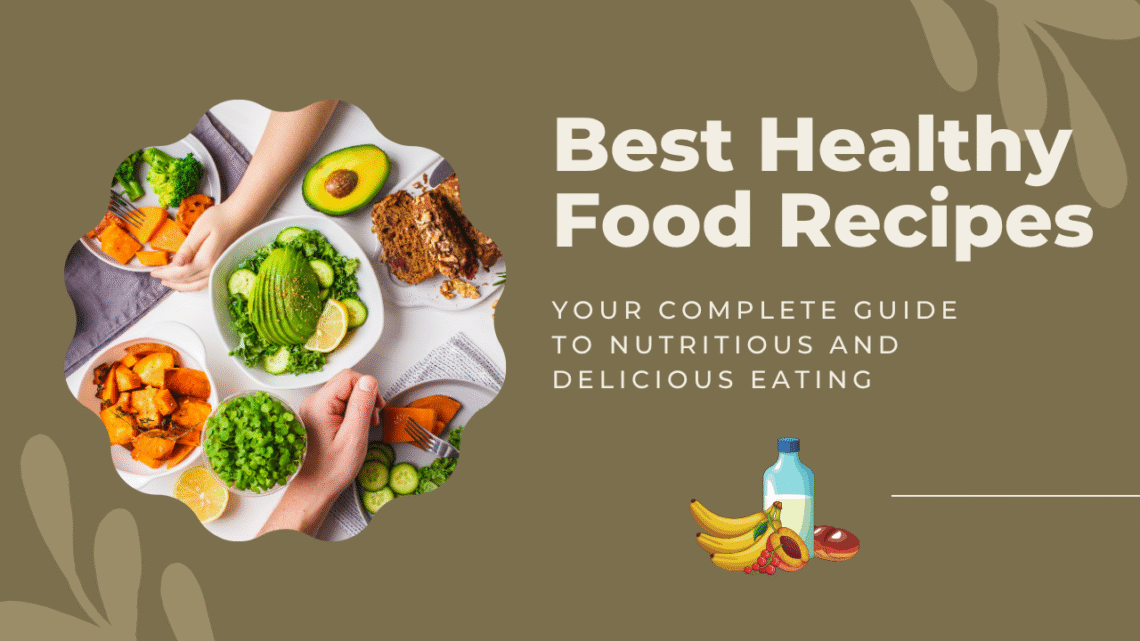Maintaining a healthy diet doesn’t mean sacrificing flavor, joy, or variety in your meals. In fact, with the right ingredients, techniques, and mindset, healthy food recipes can be just as satisfying and exciting as traditional comfort foods—while offering countless benefits for your body and mind.
In this comprehensive guide, you’ll discover the benefits of eating healthy, the top 8 expert tips for creating healthy food recipes, and a variety of delicious, easy-to-follow recipes you can start using today. Whether your goal is to lose weight, boost energy, support immunity, or simply feel your best, this article has something for everyone.
Why Healthy Eating Matters
Before diving into recipes and tips, it’s important to understand why healthy food matters:
- Boosts energy and mental focus
- Supports digestion and metabolism
- Strengthens immunity
- Improves skin, hair, and overall appearance
- Helps manage weight and prevent chronic diseases
Eating healthy doesn’t mean eating bland. It means making smart choices—like choosing whole foods, reducing processed ingredients, and balancing macronutrients.
Top 8 Tips for Creating Healthy Food Recipes

Here are eight powerful and practical tips to help you prepare healthy meals every day:
1. Choose Whole Ingredients Over Processed Foods
The core of all healthy food recipes lies in the quality of ingredients. Choosing whole, natural foods such as fresh fruits, colorful vegetables, whole grains, legumes, nuts, seeds, and lean proteins sets the stage for balanced and nourishing meals. These ingredients are packed with vitamins, minerals, fiber, and antioxidants essential for overall well-being.
When preparing healthy food recipes, it’s important to avoid processed and refined foods that contain hidden sugars, trans fats, preservatives, and artificial additives. These can disrupt digestion, spike blood sugar levels, and increase the risk of chronic diseases. Whole foods, on the other hand, provide sustainable energy and support gut and immune health.
Making intentional ingredient choices allows you to enjoy meals that are not only delicious but also functional. Whether you’re cooking at home or meal prepping for the week, focusing on natural, nutrient-rich items is the first and most important step toward creating satisfying and effective healthy food recipes.
✅ Example Swap: Use rolled oats instead of sugary boxed cereals for breakfast.
2. Cook at Home Whenever Possible
Cooking at home is one of the most effective ways to support a healthy lifestyle. When you prepare meals yourself, you gain full control over the ingredients, portion sizes, and cooking techniques used. This makes it easier to avoid excessive sugar, sodium, and unhealthy fats often found in takeout or processed foods.
By creating your own healthy food recipes, you can tailor meals to your specific health goals—whether that’s managing weight, improving digestion, or increasing energy. You can also accommodate dietary needs like gluten-free, dairy-free, or plant-based preferences with ease. Plus, you’ll know exactly what’s going into your body.
Home cooking also allows you to experiment with new ingredients and flavors, making eating healthy a creative and enjoyable experience. Over time, preparing your own healthy food recipes builds better habits, saves money, and enhances your connection to what you eat—resulting in long-term benefits for both your health and well-being.
✅ Tip: Batch cook and meal prep on weekends to save time during the week.
3. Incorporate More Plant-Based Foods

Incorporating more plant-based meals into your diet is a powerful way to support your overall well-being. Vegetables, legumes, fruits, whole grains, nuts, and seeds are loaded with fiber, antioxidants, and essential nutrients that promote heart health and help reduce inflammation throughout the body.
You don’t need to adopt a strict vegan lifestyle to benefit from plant-based eating. Simply making vegetables the centerpiece of more meals can have a major impact. Try building your healthy food recipes around greens, beans, or grains instead of relying heavily on meat or processed items. This adds variety and improves digestion.
Experimenting with plant-based dishes also opens the door to creative cooking. Think colorful stir-fries, lentil soups, roasted veggie bowls, and hearty salads. These healthy food recipes are not only nourishing but also delicious and satisfying—proving that good nutrition doesn’t mean compromising on taste or comfort.
✅ Try this: Swap meat with lentils in tacos or beans in chili.
4. Use Healthier Cooking Techniques
The way you cook your food has a major impact on its nutritional value. For truly effective healthy food recipes, it’s best to avoid deep frying, which adds unnecessary fats and calories. Instead, opt for healthier methods like baking, steaming, sautéing, grilling, or air frying, which preserve flavor while reducing oil use.
These cooking techniques help maintain the natural nutrients in your ingredients—especially when preparing vegetables, lean proteins, and whole grains. Baking and grilling create satisfying textures without the need for heavy batter or grease, while steaming locks in vitamins and minerals without added fat.
Air frying, in particular, has become a popular alternative to traditional frying, offering a crispy texture with minimal oil. When you apply these methods to your healthy food recipes, you’ll find that meals remain both tasty and nourishing. With the right cooking approach, it’s easy to enjoy delicious food that supports your wellness goals.
✅ Try this: Bake sweet potato wedges with olive oil and herbs instead of frying.
5. Balance Your Macronutrients
Creating healthy food recipes starts with understanding how to build a balanced plate. The ideal meal includes a combination of lean protein, healthy fats, and complex carbohydrates. This trio not only supports energy levels but also helps your body function at its best.
Protein is essential for repairing tissues and building muscle. Healthy fats—like those from avocados, nuts, seeds, and olive oil—support brain health and hormone balance. Complex carbs, found in whole grains, legumes, and vegetables, provide long-lasting fuel and essential fiber for digestion.
When you incorporate all three macronutrients into your healthy food recipes, you’ll feel fuller for longer, avoid energy crashes, and keep your blood sugar stable throughout the day. Whether it’s a quinoa bowl with grilled chicken and veggies or a stir-fry with tofu and brown rice, balancing your plate is key to making meals both satisfying and nutritious.
✅ Example Meal: Grilled chicken (protein), brown rice (carbs), and avocado (healthy fat).
6. Don’t Skip Herbs and Spices
Herbs and spices do more than just add flavor—they bring a variety of health benefits to your meals. Many common seasonings, such as turmeric, garlic, ginger, cinnamon, and oregano, are packed with antioxidants and have strong anti-inflammatory properties. Including them in your cooking can help support immunity and reduce the risk of chronic disease.
When preparing healthy food recipes, proper seasoning can make a big difference in how enjoyable your meals are. Instead of relying on excess salt, sugar, or sauces, using fresh herbs and warming spices enhances taste naturally—without compromising nutrition. From savory stews to zesty salads, flavor is key to satisfaction.
Experimenting with different herbs and spices also brings variety to your meals, helping you stay committed to your health goals. By seasoning thoughtfully, you’ll find that your healthy food recipes become just as delicious and crave-worthy as your favorite comfort foods—only better for your body.
✅ Top Picks: Turmeric, garlic, ginger, oregano, cinnamon, cayenne.
7. Control Portion Sizes

While healthy food recipes are packed with nutrients, it’s still important to keep portion sizes in check. Eating too much of even the healthiest meals can lead to weight gain over time. Calories still count, and large portions can easily add up—especially when mindless eating becomes a habit.
One simple way to manage portion control is by using smaller plates and bowls. This visual trick helps prevent overeating and encourages better portion awareness. Pair it with mindful eating techniques like chewing slowly, savoring each bite, and stopping when you feel satisfied rather than full.
Tuning into your body’s hunger and fullness cues can help you build a balanced relationship with food. No matter how nutritious your healthy food recipes are, being conscious of how much you eat is key to supporting weight management, digestion, and long-term wellness. Consistency and mindfulness can make all the difference in maintaining a healthy lifestyle.
✅ Tip: Fill half your plate with vegetables before adding grains and protein.
8. Hydrate and Support Digestion
Good digestion plays a vital role in how your body processes and absorbs nutrients from the food you eat. Even the most nutrient-rich healthy food recipes won’t benefit you fully if your digestive system isn’t functioning properly. Supporting your digestion ensures your body can effectively turn food into energy and nourishment.
Simple habits can make a big difference. Drinking water with your meals helps move food through your digestive tract and keeps things running smoothly. Choosing fiber-rich ingredients—like leafy greens, legumes, whole grains, and fruits—can further improve gut health and regularity.
Chewing your food thoroughly is another underrated step that enhances nutrient absorption. It breaks down food mechanically and signals your body to release digestive enzymes. By combining healthy food recipes with mindful eating practices, you promote better digestion, reduce bloating, and get the most from every meal. A happy gut supports a healthier, more energized you.
✅ Pro Tip: Start meals with a glass of water and eat slowly to avoid overeating.
Sample Healthy Food Recipes
Here are some delicious and easy-to-make recipes to help you apply what you’ve learned:
🥗 1. Mediterranean Chickpea Salad
Ingredients:
- 1 can chickpeas (rinsed)
- 1 cucumber (diced)
- 1 tomato (chopped)
- 1/4 cup red onion (sliced)
- 2 tbsp olive oil
- 1 tbsp lemon juice
- 1 tsp oregano
Instructions: Mix all ingredients. Chill before serving. A perfect lunch or side dish packed with protein, fiber, and antioxidants.
🍛 2. Quinoa Veggie Stir-Fry
Ingredients:
- 1 cup cooked quinoa
- 1 cup broccoli
- 1 carrot (shredded)
- 1/2 bell pepper (sliced)
- 1 tbsp olive oil
- 1 tbsp low-sodium soy sauce
Instructions: Stir-fry veggies in oil, add cooked quinoa and soy sauce. Cook 3-5 minutes. A fiber-rich, gluten-free dish.
🥙 3. Grilled Chicken Wraps
Ingredients:
- Whole wheat tortilla
- Grilled chicken breast (sliced)
- Hummus or avocado
- Spinach or lettuce
- Tomato slices
Instructions: Spread hummus, layer ingredients, and roll up. A lean, protein-packed lunch or dinner option.
🍓 4. Berry Yogurt Parfait

Ingredients:
- 1/2 cup Greek yogurt
- 1/2 cup mixed berries
- 2 tbsp oats or granola
- 1 tsp chia seeds
Instructions: Layer yogurt, berries, and oats in a glass. A protein-rich breakfast or snack with probiotics and antioxidants.
🥘 5. Lentil and Sweet Potato Curry
Ingredients:
- 1 cup red lentils
- 1 sweet potato (cubed)
- 1/2 onion (chopped)
- 1 garlic clove
- 1 tbsp curry powder
- 2 cups water or broth
Instructions: Sauté onion and garlic, add curry powder, lentils, sweet potato, and water. Simmer 20 minutes. A comforting, plant-based dinner.
🍲 6. Green Detox Smoothie
Ingredients:
- 1 banana
- 1/2 cup spinach
- 1/2 cucumber
- 1/2 cup water or coconut water
- 1 tsp flaxseed
Instructions: Blend all until smooth. Refreshing and hydrating, rich in vitamins and fiber.
🥣 7. Oats with Almond Butter & Banana
Ingredients:
- 1/2 cup rolled oats
- 1 cup water or almond milk
- 1 tbsp almond butter
- 1/2 banana (sliced)
- Cinnamon to taste
Instructions: Cook oats, top with almond butter, banana, and cinnamon. Great for energy and heart health.
🥗 8. Avocado and Egg Toast
Ingredients:
- 1 slice whole grain bread
- 1/2 avocado (mashed)
- 1 poached or boiled egg
- Salt, pepper, chili flakes
Instructions: Toast bread, spread avocado, top with egg and seasoning. A balanced breakfast or post-workout meal.
Healthy Food Recipe Myths Debunked

Let’s clear up some common misconceptions:
- Myth: Healthy food is boring.
✅ Truth: With spices, herbs, and colorful produce, healthy meals are full of flavor. - Myth: Healthy eating is expensive.
✅ Truth: Staples like beans, rice, oats, and frozen veggies are affordable and nutritious. - Myth: You need to eat “clean” 100% of the time.
✅ Truth: Balance is key. Occasional treats are part of a sustainable lifestyle.
Benefits of Consistently Eating Healthy Recipes
- Weight management without strict diets
- Better mood and energy throughout the day
- Reduced risk of diabetes, heart disease, and inflammation
- Improved gut health and digestion
- Better sleep and mental clarity
- Support for skin, hair, and nails
Final Thoughts on Healthy Food Recipes
Healthy eating isn’t about being perfect—it’s about making consistent, better choices that support your well-being. You don’t need to follow strict diets or give up all your favorite foods. By incorporating more healthy food recipes into your routine, you can nourish your body with meals that are both satisfying and nutritious. The goal is progress, not perfection.
Start small by swapping out processed ingredients for whole, natural alternatives. Replace white rice with quinoa, use olive oil instead of butter, and load your plate with colorful vegetables. These simple changes make a big difference over time. As you build confidence in the kitchen, you’ll find that preparing healthy food recipes becomes second nature—and even fun. Play with spices, textures, and seasonal ingredients to keep things interesting and flavorful.
Ultimately, healthy food recipes are more than just a way to eat better—they’re a foundation for a balanced lifestyle. Cooking at home gives you control, mindful eating fosters a stronger relationship with food, and nourishing meals energize both body and mind. When you treat food as fuel, self-care, and enjoyment all in one, you’re not just eating healthier—you’re building habits that last a lifetime.
✅ Bonus Tip: Keep It Sustainable
Make it realistic, not restrictive. Focus on progress over perfection, and enjoy the journey. Your body—and taste buds—will thank you.
FAQ (Healthy Food Recipes)
1. What makes a recipe “healthy”?
A healthy recipe is one that uses nutrient-dense, whole foods such as fruits, vegetables, whole grains, lean proteins, and healthy fats. It avoids processed ingredients, excessive sugar, sodium, and unhealthy oils. A healthy recipe should offer balanced macronutrients and support your overall wellness goals.
2. Can healthy food recipes still taste good?
Absolutely! Healthy food recipes can be incredibly flavorful when you use the right herbs, spices, and fresh ingredients. Techniques like roasting, grilling, and sautéing enhance taste without extra calories. The key is learning how to season well and pair ingredients creatively.
3. Are healthy recipes more expensive to make?
Not necessarily. Many healthy staples like beans, lentils, oats, brown rice, and seasonal produce are affordable. Cooking at home also saves money compared to eating out. With a little planning and bulk buying, healthy food recipes can be budget-friendly.
4. How can I meal prep healthy recipes for the week?
Choose a few versatile recipes like grain bowls, salads, soups, or stir-fries. Cook in bulk, store in airtight containers, and refrigerate or freeze portions. Having pre-prepared meals on hand helps you stay on track with your nutrition goals and saves time.
5. What are the best ingredients to keep on hand for healthy cooking?
Keep staples like olive oil, quinoa, oats, canned beans, frozen vegetables, spices, garlic, eggs, and leafy greens. These form the base for countless healthy food recipes and allow for quick, nutritious meals any day of the week.
6. Can healthy recipes help with weight loss?
Yes. Healthy food recipes that are balanced, portion-controlled, and rich in fiber and protein can help reduce hunger, improve metabolism, and manage calorie intake—all of which support sustainable weight loss.
7. How do I make my favorite comfort foods healthier?
Make smart swaps like baking instead of frying, using whole grains instead of white flour, or replacing cream with Greek yogurt. You can also add extra veggies or reduce sugar and salt to improve nutritional value without losing flavor.
8. Are healthy recipes suitable for the whole family?
Yes! With a bit of creativity, you can make family-friendly healthy food recipes that everyone enjoys. Focus on meals with familiar flavors and fun textures, like homemade tacos, veggie-loaded pasta, or healthy casseroles.





